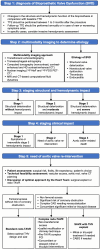Transcatheter Aortic Valve Durability: Focus on Structural Valve Deterioration
- PMID: 40530490
- PMCID: PMC12450013
- DOI: 10.1161/JAHA.125.041505
Transcatheter Aortic Valve Durability: Focus on Structural Valve Deterioration
Abstract
Transcatheter aortic valve replacement has emerged as a valuable alternative to surgical aortic valve replacement in patients with severe aortic stenosis. Given the expansion of transcatheter aortic valve replacement to lower-risk and younger populations with longer life expectancy, the durability of transcatheter heart valves (THVs) has become an important issue that may impact cardiovascular outcomes. THVs share similarities with surgical valves but have unique features, including a trend to larger effective orifice area and less prosthesis-patient mismatch, interactions with the native valve, and crimping process, that may all potentially influence a THV's life span. Multiple mechanisms may lead to bioprosthetic valve dysfunction, including structural valve deterioration, thrombosis, endocarditis, and nonstructural valve deterioration. With an incidence of up to 12.3% 5 years after transcatheter aortic valve replacement, structural valve deterioration represents the ultimate consequence of fibrotic remodeling and calcification within the bioprosthesis, driven by thrombotic and inflammatory processes involving the native aortic valve and influenced by patient and procedural factors. Understanding these mechanisms is crucial for improving THV durability.
Keywords: bioprosthetic valve failure; durability; structural valve deterioration; transcatheter aortic valve replacement; transcatheter heart valve.
Conflict of interest statement
A.T. has received a fellowship grant from Edwards Lifesciences. S.K. has received a grant from the Japan Heart Foundation/Bayer Yakuhin Research Grant Abroad. K.M. received a grant from Edwards Lifesciences (THV‐F20–142). V.S.K. has received research grants from Boehringer‐Ingelheim, Nugerontix, and Servier. J.R.C. has received institutional grants and consultant/speaker fees from Edwards Lifesciences and Medtronic. O.M. declared grants from AstraZeneca, Medtronic, and Boehringer Ingelheim. The other authors declare that they have no competing interest relevant to the manuscript.
Figures




References
-
- Vahanian A, Beyersdorf F, Praz F, Milojevic M, Baldus S, Bauersachs J, Capodanno D, Conradi L, De Bonis M, Paulis R, et al. 2021 ESC/EACTS guidelines for the management of valvular heart disease. Eur Heart J. 2021;60:ehab395. doi: 10.1093/ejcts/ezab389 - DOI
-
- Otto CM, Nishimura RA, Bonow RO, Carabello BA, Erwin JP, Gentile F, Jneid H, Krieger EV, Mack M, McLeod C, et al. 2020 ACC/AHA guideline for the Management of Patients with Valvular Heart Disease: a report of the American College of Cardiology/American Heart Association joint Committee on clinical practice guidelines. Circulation. 2021;143:e72–e227. doi: 10.1161/CIR.0000000000000923 - DOI - PubMed
Publication types
MeSH terms
LinkOut - more resources
Full Text Sources

